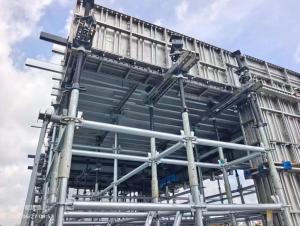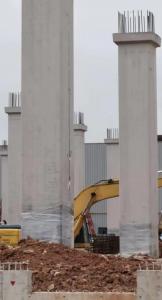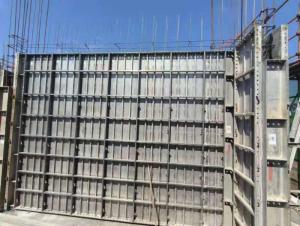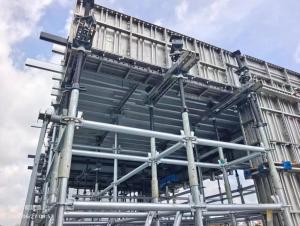High quality steel formwork system,concrete formwork, Stainless Steel Formwork
- Loading Port:
- Shanghai
- Payment Terms:
- TT or LC
- Min Order Qty:
- 1 set
- Supply Capability:
- 1000000 set/month
OKorder Service Pledge
OKorder Financial Service
You Might Also Like
Stainless steel formwork
Replaceable size aluminum formwork :400X1200mm , 400X1500mm
Advantages:
1 Stainless steel formwork, 100% follow the design of aluminum alloy formwork system, it is interchangeable, compatible and can be used together with aluminum formwork at the same time .
2 (The maintenance of the floor or wall is simple and convenient, clean and smooth, easy to remove the mold, and the surface is beautiful.)
Integrated with the thermal insulation structure, the construction will be finished is fast, the efficiency is improved, no release agent is required, the wall has good flatness after de-moulding, no leveling is required, labor cost and time are saved . The construction speed of 5-6 floors a month shortens the construction period and saves Various expenses of the construction general contractor
3Long service life, many turnover times, high recycling value
The number of turnovers is large, especially the characteristics of no dust, no need to brush or less mold release agent, and the characteristics of low renovation costs will bring unlimited optimistic prospects to it.
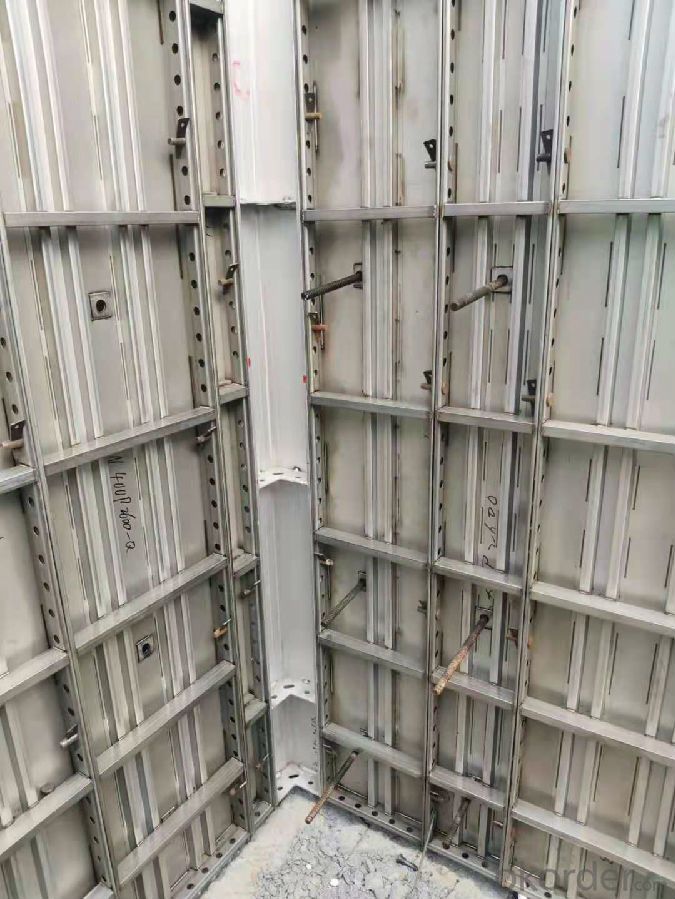


- Q:What are the different sizes and dimensions of steel formwork?
- Different construction requirements and project needs can be catered to by steel formwork, which is available in various sizes and dimensions. The typical sizes of steel formwork panels are 2 meters (6.5 feet) in height and 1 meter (3.2 feet) in width, although these measurements can differ depending on the manufacturer and specific project requirements. The thickness of steel formwork panels is usually between 12 to 14 millimeters (0.5 to 0.6 inches) to ensure they are strong enough to withstand the pressure exerted by the concrete during pouring and curing. Furthermore, steel formwork panels can be obtained in different lengths to accommodate varying wall heights and dimensions, ranging from 1 meter (3.2 feet) to 4 meters (13.1 feet) or even longer, depending on project specifications. In addition to panels, steel formwork systems consist of other components like beams, props, adjustable struts, and connectors. These components are available in different sizes and dimensions to provide support for the formwork structure and ensure stability and safety throughout the construction process. It is essential to keep in mind that the sizes and dimensions of steel formwork can vary based on the manufacturer, project specifications, and regional construction practices. Therefore, consulting with the manufacturer or a structural engineer is crucial to determine the appropriate sizes and dimensions of steel formwork required for a specific construction project.
- Q:Can steel formwork be used in high-rise construction projects?
- Yes, steel formwork can be used in high-rise construction projects. Steel formwork offers several advantages such as durability, strength, and the ability to withstand high concrete pressure. It provides a stable and efficient solution for constructing walls, slabs, and columns in high-rise buildings. Additionally, steel formwork can be easily customized and reused, making it a cost-effective choice for such projects.
- Q:Can steel formwork be used for single-sided formwork applications?
- Yes, steel formwork can be used for single-sided formwork applications. Steel formwork is known for its durability and strength, making it suitable for various construction projects, including single-sided formwork. Single-sided formwork is commonly used when only one side of the concrete structure is accessible, such as when constructing retaining walls, columns, or beams against existing structures. Steel formwork provides the necessary support and stability to hold the concrete in place until it cures and hardens. It offers a high level of accuracy and precision, ensuring that the concrete structure is formed correctly and meets the desired specifications. Steel formwork can be easily assembled and disassembled, allowing for efficient and quick construction. Additionally, steel formwork can be reused multiple times, making it a cost-effective option for single-sided formwork applications. Overall, steel formwork is a reliable and suitable choice for single-sided formwork applications due to its strength, durability, accuracy, and efficiency.
- Q:How does steel formwork contribute to the overall fire resistance of the structure?
- Steel formwork does not directly contribute to the fire resistance of a structure. However, it can indirectly enhance fire resistance by supporting the installation of fire-rated materials, such as fire-resistant coatings or insulation, which are crucial in increasing the overall fire resistance of the structure.
- Q:How does steel formwork affect the overall project budget?
- Steel formwork can have a significant impact on the overall project budget. While it may initially have a higher upfront cost compared to other formwork materials, such as wood or plastic, steel formwork offers several advantages that can help offset these expenses. Steel formwork is durable, reusable, and has a longer lifespan, reducing the need for frequent replacements or repairs. Additionally, its strength allows for a higher number of concrete pours, increasing productivity and minimizing downtime. These factors, along with reduced labor costs and improved efficiency, make steel formwork a cost-effective choice in the long run, ultimately positively impacting the project budget.
- Q:Can steel formwork be used for both horizontal and vertical construction elements?
- Indeed, steel formwork proves to be applicable for both horizontal and vertical construction components. With its versatility and durability, steel formwork emerges as a flexible and long-lasting alternative for constructing concrete structures. It boasts easy adjustability and assembly, enabling it to accommodate diverse shapes and sizes, rendering it suitable for both horizontal components such as slabs and beams, as well as vertical components like walls and columns. By providing exceptional support and stability during the concrete pouring stage, steel formwork guarantees the attainment of desired shapes and finishes for construction components. Furthermore, the ability to reuse steel formwork multiple times renders it an economically sound option for construction projects.
- Q:What are the different types of coatings applied to steel formwork panels?
- There are several types of coatings that can be applied to steel formwork panels to enhance their durability and performance. Some of the most common coatings include: 1. Galvanized Coating: This is a popular coating choice as it provides excellent corrosion resistance. The steel panels are dipped into a bath of molten zinc, which forms a protective layer on the surface. Galvanized coatings are long-lasting and can withstand harsh weather conditions. 2. Epoxy Coating: Epoxy coatings are widely used to protect steel formwork panels from corrosion and chemical damage. These coatings are applied as a two-part system, where a primer is first applied to the surface and then a topcoat is added. Epoxy coatings offer high resistance to chemicals, abrasion, and impact. 3. Powder Coating: Powder coating is a dry finishing process where a free-flowing, dry powder is electrostatically applied to the steel formwork panels. The coated panels are then heated, causing the powder to melt and form a durable and hard finish. Powder coatings provide excellent resistance to impact, chemicals, and UV rays. 4. Paint Coating: Paint coatings are widely used to enhance the aesthetic appeal of steel formwork panels. These coatings are typically applied in multiple layers, including a primer, intermediate coat, and topcoat. Paint coatings can provide basic corrosion protection, but may require regular maintenance and touch-ups. 5. Concrete Release Coating: This type of coating is specifically designed to prevent concrete from sticking to the steel formwork panels. It creates a smooth, non-stick surface that allows for easy removal of the cured concrete. Concrete release coatings are typically based on silicone or wax compounds. It is important to choose the appropriate coating for steel formwork panels based on the specific requirements of the project, including the desired level of corrosion resistance, aesthetics, and durability. Consulting with a coatings expert or a steel manufacturer can help in selecting the most suitable coating for the intended application.
- Q:What are the considerations when designing steel formwork for beams?
- When designing steel formwork for beams, there are several important considerations to take into account. Firstly, the formwork needs to be strong and durable enough to support the weight of the concrete and any additional loads, such as construction personnel or equipment. The formwork should also be designed to withstand the pressure and vibrations caused by the pouring and consolidation of the concrete. Additionally, the formwork should be designed to provide easy access for placing and compacting the concrete. This may involve incorporating openings or removable sections to allow for the proper placement and consolidation of the concrete. Furthermore, the design should consider the ease of assembly, disassembly, and reusability of the formwork. Steel formwork is often preferred due to its strength and reusability, so the design should be efficient in terms of assembly and disassembly to minimize labor and time. Lastly, safety is a crucial consideration. The formwork should be designed to ensure the safety of workers during the construction process. This may involve incorporating features such as guardrails, non-slip surfaces, or other safety measures to prevent accidents or falls. In summary, when designing steel formwork for beams, factors such as strength, durability, accessibility, reusability, and safety should all be carefully considered to ensure a successful and efficient construction process.
- Q:How does steel formwork handle surface imperfections in concrete?
- Steel formwork is a rigid and durable material that is able to handle surface imperfections in concrete effectively. Its strength and stability allow it to support the weight of wet concrete, preventing any deformation or distortion caused by uneven surfaces. Additionally, steel formwork provides a smooth and uniform surface, minimizing any irregularities or blemishes that may occur during the pouring and curing process of concrete. Overall, steel formwork offers excellent resistance to surface imperfections, resulting in high-quality and aesthetically pleasing concrete finishes.
- Q:What are the advantages of using steel formwork?
- There are several advantages of using steel formwork. Firstly, steel formwork is highly durable and can withstand multiple uses, making it cost-effective in the long run. Secondly, it provides a smooth and consistent finish to the concrete structure, resulting in high-quality construction. Additionally, steel formwork is lightweight and easy to handle, which reduces labor and transportation costs. It also offers flexibility in terms of design modifications and can be easily assembled and dismantled. Lastly, steel formwork is fire-resistant and offers better safety measures compared to other formwork materials.
1. Manufacturer Overview |
|
|---|---|
| Location | |
| Year Established | |
| Annual Output Value | |
| Main Markets | |
| Company Certifications | |
2. Manufacturer Certificates |
|
|---|---|
| a) Certification Name | |
| Range | |
| Reference | |
| Validity Period | |
3. Manufacturer Capability |
|
|---|---|
| a)Trade Capacity | |
| Nearest Port | |
| Export Percentage | |
| No.of Employees in Trade Department | |
| Language Spoken: | |
| b)Factory Information | |
| Factory Size: | |
| No. of Production Lines | |
| Contract Manufacturing | |
| Product Price Range | |
Send your message to us
High quality steel formwork system,concrete formwork, Stainless Steel Formwork
- Loading Port:
- Shanghai
- Payment Terms:
- TT or LC
- Min Order Qty:
- 1 set
- Supply Capability:
- 1000000 set/month
OKorder Service Pledge
OKorder Financial Service
Similar products
New products
Hot products
